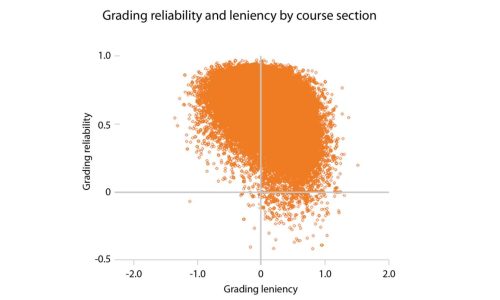If you’re even a casual observer of the trends in higher education, odds are you’re familiar with the persistent challenge of grade inflation. The rise of college grades—in the absence of any evidence that today’s college student has become harder working than the students of the past—has led to questions about the role instructors likely play. Are today’s college instructors holding their students accountable and taking the time to provide accurate feedback?
The question is particularly germane for teacher candidates, who must enter classrooms ready to teach on Day 1. And yet, our 2014 report, Easy A’s and What’s Behind Them, revealed teacher preparation programs to be particularly egregious offenders when it comes to grade inflation. In our sample of over 500 institutions, we found that grading standards were much lower for teacher candidates than for students pursuing other majors at a majority (58 percent) of those institutions.
Given the scale of this problem in teacher prep, we were particularly interested in a new study that provides fresh insight on the roots of grade inflation for all college students. Ido Millet, a professor at Penn State Behrend, assembled a massive dataset that included the grades awarded across more than 50,000 course sections and the GPAs of students enrolled in them. His analysis relied on two measures. The first, “leniency,” is the difference between the average grade for a course and the average GPA of the students enrolled in that course. The second measure, “reliability,” is a measure of how closely course grades align with students’ overall GPAs.
The figure below shows the 50,000+ course sections graphed according to their leniency and reliability. In the upper left corner, we see that there are a lot of tough courses (those that score low on leniency) for which the grading is fairly reliable. In comparison, there are relatively few tough courses for which the grading is unreliable (notice that the bottom left corner of the graph is fairly empty).

Source: Ido Millet (2016)
So, why might a tough course have more reliable grading? Millet ventures a guess that it may be a matter of the quality of assignments given to the students in the class. Being an “easy grader” doesn’t cause a professor to be unreliable; if that were the case, the graph above wouldn’t show so many courses for which the grading was both lenient and reliable (upper right corner). What’s more likely is that unreliable assessment tools lead an instructor to be lenient. In other words, if course assignments do not permit the instructor to make an accurate judgment about the quality of the work, then it becomes more likely that an instructor will inflate grades rather than risk giving a good student a low grade unfairly.
While Millet didn’t have access to course assignments for his study, NCTQ’s own review of assignments given in teacher prep courses would suggest that his hypothesis is spot on. In Easy A’s, we analyzed assignments across multiple majors (nursing, business, and psychology, in addition to teacher prep) for a subset of seven institutions. By a substantial margin, assignments given in teacher prep courses were more likely to require an instructor to base grading on a subjective judgment.
Consider the assignments that we commonly find in teacher preparation programs: Reflect on your experience learning how to read. Write a philosophy of math instruction. Conduct a field observation. These assignments all require course instructors to trust the reality their students describe. And for each, the line between a right answer and a wrong answer—between someone prepared to become a teacher and someone who is missing the mark—is obscure at best. How could an instructor possibly grade such assignments reliably? More importantly, how will graduates respond when they begin a career that is much less forgiving than the college classroom?
More like this

National Council on Teacher Quality opposes the executive order to dismantle the Department of Education

Black History Month: Learning to read is a civil right

As seasons change, one thing remains the same: The persistent lack of diversity in the teacher workforce


